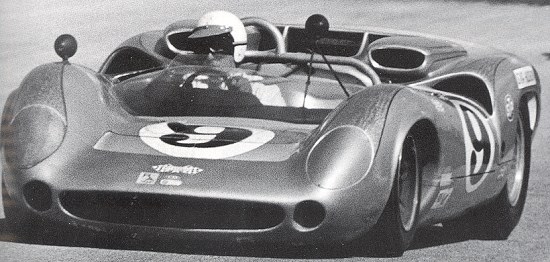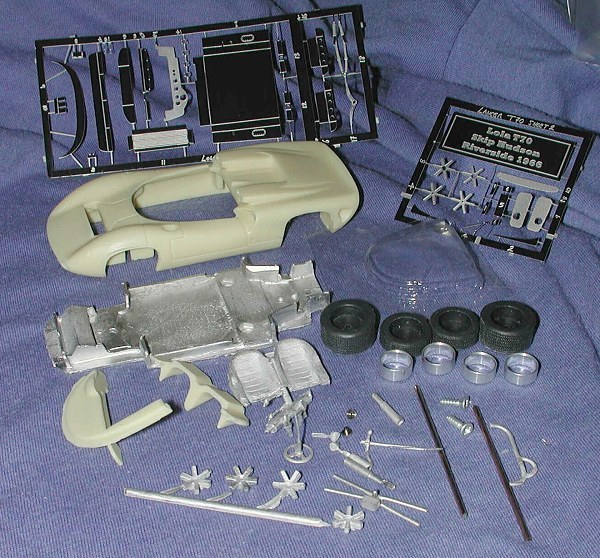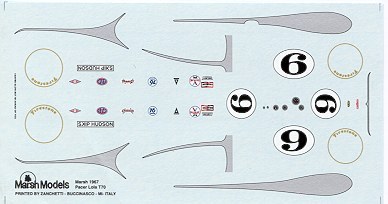
|
KIT: |
Marsh Models 1/43 Skip Hudson Lola T-70 |
|
KIT # |
MM24H |
|
PRICE: |
$49.99 |
|
DECALS: |
One car |
|
REVIEWER: |
|
|
NOTES: |
Multimedia kit |

|
HISTORY |
Normal power-plant was a small block V-8 of some sort generally in the 275-350 cubic inch range. Many were powered by Chevrolet engines, but you could also find Fords and Buick/Olds/Pontiac (BOP) engines as well. The car was initially raced in 1965 and was the most widely used sports racer of its type through 1967. Literally dozens of teams fielded the T-70 and it saw a great deal of success during that time, winning the initial Can Am in 1966 driven by John Surtees.
Without a doubt, the most
beautiful of the T-70s was the one driven by Skip Hudson during 1966/67
with the Lancer racing team. Though not a top contender due to chronic
under-funding, the car sported a redesigned upper rear deck area that set
it aside from others in the field. Sadly, this car did not survive having
been totally destroyed in a crash at Riverside while shooting a movie.
|
THE KIT |

For those of you who have had no experience with short run 1/43 car kits, this one is pretty typical of the genre. Not that long ago, there would have been no resin in it and the body would have also been done in metal. When I went through a stint of building these kinds of kits about 20 years back, that is how they were done. However, the level of detail available in resin has changed things a bit. As you can see, the 'frame' and many other bits such as the roll bar, wheel inserts, seat and such are in pewter. This kit has two frets of etched metal for various inserts and for the cockpit tub, dash and spoilers. In fact, the larger sheet is a generic Lola T-70 offering and not all will be used. The wheels are a combination of turned aluminum, pewter and etched metal. The tires are a single piece and are a hard rubber, so there is no fear of these splitting as time goes along.
The body is held to the frame with two screws. Care must be
used when applying these and the smart builder will want to predrill the
holes prior to using them to prevent problems with the resin splitting. The
detail level of the metal bits is quite good as is the resin body. The
edges on the resin parts will need some
 clean up as will the
various openings of the body. No air bubbles were noted, which is a big
plus. The vacuformed windscreen fits into the opening quite well during a
test fit.
clean up as will the
various openings of the body. No air bubbles were noted, which is a big
plus. The vacuformed windscreen fits into the opening quite well during a
test fit.
Instructions are a little on the basic side for those of us used to building aircraft kits. It consists of an exploded view of all the parts with color information supplied where it is needed. Frankly, it is more than adequate for the build as there are not a lot of parts involved. The other side of the single sheet instructions contain color images of the completed model and decal placement. No definitive color is recommended other than a silver that contrasts with the decals. Decals look to be quite good and are printed in Italy. (Marsh is a British company).
|
CONCLUSIONS |
The kit looks just super in the box and should be a relatively simple build for those who are used to dealing with resin, etched and cast metal. Though it won't be a large model, it will be a beauty.
|
REFERENCES |
If you would like your product reviewed fairly and quickly by a site that has over 200,000 visitors a month, please contact me or see other details in the Note to Contributors.